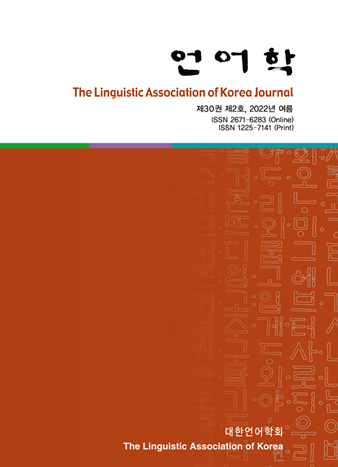대한언어학회 전자저널

30권 2호 (2022년 6월)
- Acquisition of /ɯ/ and /ʌ/ Variation by Mobile Kyungsang Korean and Seoul Korean Speakers
-
Yoojin Kang
Pages : 49-70
Abstract
Kang, Yoojin (2022). Acquisition of /ɯ/ and /ʌ/ variation by mobile Kyungsang Korean and Seoul Korean speakers. The Linguistic Association of Korea Journal, 30(2), 49-70. This study examines the /ɯ/ and /ʌ/ merger in North Kyungsang Korean in the speech of speakers who were born in Seoul and later moved to North Kyungsang after the age of 20 and the /ɯ/ and /ʌ/ contrast in Seoul Korean in the speech of speakers who were born in North Kyungsang and later moved to Seoul as adults. This study focuses on stylistic variation in the use of a new dialect feature in two contexts: Word list and conversational interview. Moreover, this study addresses how various extralinguistic factors, including gender, length of stay in a new region, language attitudes and awareness of the /ɯ/ and /ʌ/ variation, affect mobile speakers' linguistic behavior. The major finding is that both groups of mobile speakers produce a distinction between /ɯ/ and /ʌ/ in word list and interview speech, and there is no appreciable shift in vowel quality in these two contexts.
Keywords
# second dialect acquisition # /ɯ/ and /ʌ/ merger # /ɯ/ and /ʌ/contrast # change over the lifespan # mobile adults
References
- Bortoni-Ricardo, S. M. (1985). The urbanization of rural dialect speakers: A sociolinguistic study in Brazil. Cambridge: Cambridge University Press.
- Bybee, J. (2002). Word frequency and context of use in the lexical diffusion of phonetically conditioned sound change. Language Variation and Change, 14, 261-290.
- Chambers, J. K. (1992). Dialect acquisition. Language, 68, 673-705.
- Jeong, Y.-H. (2008). 19segi gyeongsangbangeon-ui moeumsangseung hyeonsang gochal (‘A study of the vowel raising of the 19th Kyeongsang dialect’). Korean Linguistics, 38, 371-399.
- Kerswill, P. (1994). Dialects converging: Rural speech in urban Norway. Oxford: Clarendon Press.
- Kim, M.-S. (1986). Gyeongsangdo bangeon /eo/ wa /eu/moeum-ui silheomeumseonghakjeok yeongu (‘Study of merger between EO and EU in the Kyungsang dialect’). Unpublished master’s thesis, Kyungpook National University, Daegu, South Korea.
- Kwon, K.-K. (2001). Hyeondaegugeo-eseoui moeumchegye byeonhwa-ui umjigim- edaehayeo: Jeolmeunsedae-uimal-eul jungsim-eulo (‘On systematic aspects of vowel change in the contemporary Korean’). Journal of the Linguistic Society of Korea, 30, 29-48.
- Labov, W. (1966). The social stratification of English in New York City. Washington D.C.: Center for Applied Linguistics.
- Labov, W. (1994). Principles of linguistic change: Internal factors. New Jersey: Blackwell.
- Lobanov, B. M. (1971). Classification of Russian vowels spoken by different speakers. Journal of the Acoustical Society of America, 49, 606-608.
- Payne, A. C. (1980). Factors controlling the acquisition of the Philadelphia dialect by out-of-state children. In W. Labov (Ed.), Locating language in time and space (pp. 143-178). New York: Academic Press.
- Park, J.-D. (2004). /eo/ wa /eu/ saengseong-ui dong-jeok gwanlyeon seong gyeongsangdo bangeon-eul daesang-eulo (‘The diachronic relatedness of the creation of /E/ and /Ǝ/ in Gyeongsang-do dialect of Korean’). Korean Language, 264, 25-65.
- Trudgill, P., & Foxcroft, T. (1978). On the sociolinguistics of vocalic mergers: Transfer and approximation in East Anglia. In P. Trudgill (Ed.), Sociolinguistic patterns in British English (pp. 69-79). London: Edward Arnold.